
Dehydrating is the best way to preserve the essence of a raw apple, as well as other fruits and vegetables, because it doesn’t doesn't subject foods to high temperatures associated with traditional canning methods.
For safety reasons, low-acid foods are heated to temperatures of
240°F degrees in a pressure canner. High-acid produce reaches a temperature of
212°F in a water-bath canner. When a raw food is heated to an internal temperature of
120°F or higher, much of its nutritional value is lost, especially enzymes. Canning also leaches out water soluble vitamins and minerals, which further depletes the healthful qualities of raw-living foods.
But don’t be fooled by the dehydrated stuff in the stores. When you read the list of ingredients in commercially prepared "dried" foods, you’ll find in addition to chemicals used for preservation and other purposes, some may contain saturated fats, indicating that the food may have been fried rather than simply having the moisture removed.

Really, home-dried foods are BETTER than those in the Health Food Store! There are a variety of reasons for this opinion, but the best is that you know exactly what’s in stuff. AND you know how fresh the original product was, and how it was handled after landing in your kitchen. Then there’s cost—home-dried fruits and vegetables are almost always less expensive than those found in a store. All in all, home-drying puts us more in control…
Consider a typical bag of trail mix, for instance: A 5-oz. bag of trail mix costs about $1.89 at the supermarket. Make your own for about 75¢. And how about those yummy but very expensive Power Bars? High energy bars cost about $2.89 each at the store. Make your own for about 75¢ each.

I’m convinced and have been researching various makes and models of dehydrators in regards to overall cost, costs related to the actual dehydrating, convenience in use and cleaning, etc. Many different electric dehydrator models are available, so I went to one of my favorite sources of objective information on such topics, MOTHER EARTH NEWS. Their tester settled on four that best represent the various designs available: L'Equip's Model 528, Nesco/American Harvest's Gardenmaster, Excalibur's Large Garden and Living Foods' Jumbo dehydrator.
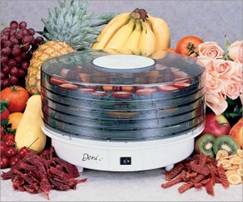
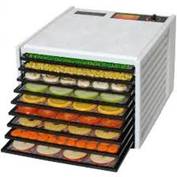
Home-food dehydrators fall into two categories: those with stackable trays, and those constructed of a rigid box with removable shelves. Size is a factor; most fit on a countertop, but larger models are free-standing and require more space. Some models have base-mounted fans that move hot air vertically; one has a rear-mounted fan for moving air horizontally; yet another uses convection drying, with no fan at all.
MOTHER EARTH’s tester put these four different models through their paces during the peak of the humid harvest season in Iowa, where he lived. Each dehydrator dried lots of herbs and vegetables with comparable ease, but the fleshy crops, like tomatoes and peaches, put the dehydrators to the ultimate test, determining their maximum capacity, efficiency and overall effectiveness.
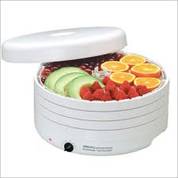
And what about stacking all those trays? L'Equip's Model 528, which has rectangular trays, and Nesco/American Harvest's models, with round trays, are plastic stackable units with base-mounted fans. The L'Equip has six trays, expandable to a stack of 20; two of the Nesco/American Harvest models have four trays, expandable to 12. Nesco's Gardenmaster, which is designed for less bulky harvests such as herbs or dried flowers, can accommodate up to 30 trays.
While these models may stack up to 30 inches tall, they have a small footprint and consume little counter space. They also provide the least expensive way to get started with food dehydrating, but they ALL share one big limitation: Uneven heat distribution in the stack means that the trays closest to the heat element and fan dry much faster than those at the top of the stack. Diligent tray rotation is critical, especially if very fleshy foods are being dried. And while perfectly suitable for drying fruits, vegetables, fruit leathers, herbs and jerky, these machines cannot readily be adapted for any of the other uses the box-and-shelf models can claim.
The researcher tested two rigid box designs with removable shelves that can be adapted for other warming or drying uses in addition to food dehydration: Excalibur's nine-tray large Garden model, with 15 square feet of drying space, and Living Foods' Jumbo model, with nine trays and 31 square feet of space.
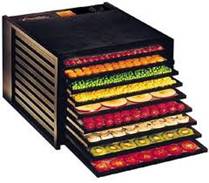
Excalibur's dehydrator designs position the heat source and fan at the back of the shelves instead of beneath them. Hot air blowing across the shelves eliminates the bothersome need for tray rotation. And the Large Garden model is big enough, with some shelves removed, to allow other uses, such as leavening bread, culturing yogurt or drying bulky items.
Instead of using a fan, Living Foods' dehydrators rely on convection drying. Heat, generated by a heating element mounted at the base of the box, rises through the trays. Living Foods' founder, Jen MacManiman, says a benefit of convection drying is that it eliminates the possibility of contaminating foods with dirt that fans can suck into a dehydrator. However, placing the fan-powered dehydrator in a clean space remedies that potential problem.
Convection heating allows silent operation and less use of electricity but it also takes twice as long to dry bulky, moisture-laden foods like tomatoes and peaches. The longer the drying time (especially during periods of high humidity), the more the dried product's flavor and keeping quality are reduced.
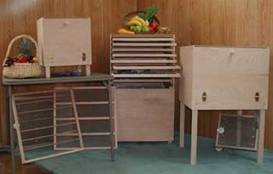
Despite their slower drying time in humid conditions, Living Foods' dehydrators may be the most versatile on the market. Besides making yogurt and leavening bread, these dehydrators also can soften honey or butter, re-crisp crackers or popcorn, sprout seeds or hatch chicks. The company claims its machines have been used to dry not only fruits, vegetables and meats, but also flowers, paper mache crafts, fine lingerie, rain-soaked boots and gloves, pasta, freshly glued items, children's artwork, tie-dyed clothing and water-damaged books or papers.
It was found that as long the Living Foods' Jumbo wasn’t overloaded with wet items during extremely humid conditions, it successfully produced an abundance of dried food. And the quiet, fan-free operation was an added bonus.
Before We Buy: If you're considering drying speciality items, investigate which models can accommodate your needs. Stick-proof fruit leather sheets, tray screens, jerky spices or kits, and very good handbooks, including recipe books, are sold by most dehydrator dealers. Besides these accessories, Excalibur also sells a variety of peelers and slicers, and a 156-page, illustrated book,
Preserve It Naturally II: The Complete Guide to Food Dehydrating, which contains many unique recipes. Living Foods markets a heavy-duty tray to support weightier jobs like yogurt-making; a grow box for starting seeds; a sprouting tube kit; and their food dehydrating handbook,
Dry It — You'll Like It!
 So the bottom line:
So the bottom line: All of the dehydrators tested had their appropriate applications, and all performed well under most conditions. MOTHER EARTH NEWs suggests we determine our needs, space limitations and budget before we buy. When it comes down to preserving food flavors and quickly drying fruits, vegetables and meats, especially when fully loaded and under humid conditions, the Excalibur Large Garden model won the highest praise. Its rear-mounted fan simply did the best job.
Contribute to the Cook'n Club!
DVO would love to publish your article, prose, photography and art as well as your cooking, kitchen and nutrition tips, tricks and secrets. Visit the Newsletter Submission / Win Win for All section in our Forum for more information and details.


